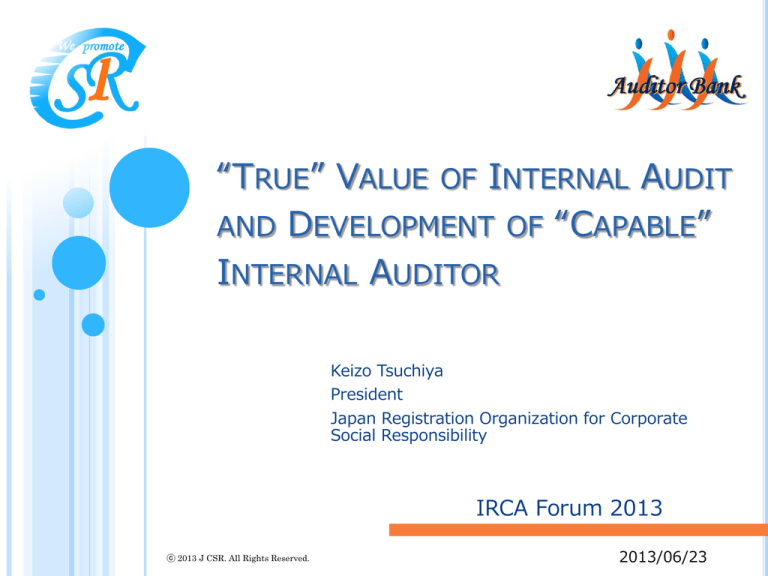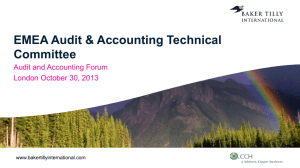
“TRUE” VALUE OF INTERNAL AUDIT
AND DEVELOPMENT OF “CAPABLE”
INTERNAL AUDITOR
Keizo Tsuchiya
President
Japan Registration Organization for Corporate
Social Responsibility
IRCA Forum 2013
ⓒ 2013 J CSR. All Rights Reserved.
2013/06/23
SIGNIFICANT INTEREST
IN INTERNAL
AUDIT
Amount of Information Uploaded to the Internet
Importance of Internal Audit:
1,210,000 hits
Credibility of Internal Audit:
1,260,000 hits
Value of Internal Audit:
1,500,000 hits
Effectiveness of Internal Audit:
1,860,000 hits
Are they a large number or small number?
Corporate Value:1,260,000 hits (the same as “Credibility of Internal
Audit”)
Computer Virus (including virus):889,000 hits, which is far less
than the above!!
Akashiya Sanma:1,850,000 hits
Search results of “Yahoo! JAPAN“ on May 5, 2013
ⓒ 2013 J CSR. All Rights Reserved.
2
VALUE
ⓒ 2013 J CSR. All Rights Reserved.
OF INTERNAL
AUDIT
VALUE OF INTERNAL AUDIT
Cost vs. Effectiveness (Value)
Calculate internal audit costs
Annual cost of training to develop internal auditors or use of external
personnel as internal auditor
Mandays of internal audit
- Mandays for audit planning, Mandays for audit execution
(auditors/auditees), Mandays for analysis/wrap-up and reporting
Example:
An organization with 200 employees and 10 Departments to be audited
5 internal auditors (appointed from different Departments in the organization)
3 internal audit teams (including 1 observer)
Pre-audit training: 1 day(by an external tutor)
5 mandays + Tutor fee
Preparation for internal audit (Collection of information and preparation of internal
audit plan): 1 day/team (6 mandays in total))
Internal audit: 3 days
Mandays on the auditor side: 6mandays
Mandays on the auditee side: 6 mandays
Analysis/Wrap-up: 1 day/team (6 mandays in total)
Reporting: 0.5 day/team (3 mandays in total)
Total mandays + External tutor fee and all other expenses: 1.3 million yen
ⓒ 2013 J CSR. All Rights Reserved.
4
VALUE OF INTERNAL AUDIT
Effectiveness (Value)
Level of usefulness of information acquired by internal audit
Level of usefulness for top management・・How well does internal
audit report meet expectations of top management?
Example:
Internal Audit Report
Nonconformity: Record of xxx training was not kept in Department Y.
Summary: 3 concerns and 8 opportunities for improvement
It was found that training records were not kept in some
Departments; e.g. Study session about accidents taking
place in competitors.
Interesting information
was delivered
100
80
Not interested
60
40
20
0 (%)
Value of internal audit for top management:
1.3 million yen x 30%=390,000 yen
ⓒ 2013 J CSR. All Rights Reserved.
5
VALUE OF INTERNAL AUDIT
Value to provide top management with useful information
Matured
Acceptable
Audit results containing more
than 80% of information that top
management wanted
Value: 1.04M~1.3M yen
Audit
results
containing
60%~80 % of information that
top management wanted
Value: 780,000~1.04M yen
Audit
results
containing
20%~60 % of information that
top management wanted
Value: 260,000~780,000 yen
Valuable information that top
management can use as useful
information
Less valuable information that
top management can use just
as reference
Limited quality of internal
audit that may overlook risks
of
accidents
and
miss
opportunities for improvement
in operations
Not
Audit results containing less than 80% of information collected
Established 20% of information that top in internal audit is extremely
management wanted
low in value for the use of
Value: 0~260,000 yen
business management.
Immature
ⓒ 2013 J CSR. All Rights Reserved.
6
VALUE OF INTERNAL AUDIT
Internal audit must contribute to achievement of objectives
and targets of an organization.
Internal audit must appropriately report changes in risks
relating to management of an organization.
Internal audit must satisfy expectations of top management in
correctly reporting current status of an organization.
Internal audit is not a means for certification, but an effective
means to implement a management system.
Internal audit is also an activity to demonstrate validity of
autonomous management of an organization.
Valid in terms of customer (public) expectations,
competitiveness and efficiency
⇒ Internal audit also provides useful information for
communication with the third party.
Internal audit is a professional work, but anyone can conduct it
if he/she is familiar with an organization. It is not difficult to
create value. It is necessary, however, to appoint those who
are highly ethical and trusted.
⇒ Enhance quality of assessment!
Enhance quality of analysis and evaluation!
ⓒ 2013 J CSR. All Rights Reserved.
7
DEVELOPMENT
~ A MEANS
TO
OF INTERNAL
DIRECTLY ENHANCE VALUE
ⓒ 2013 J CSR. All Rights Reserved.
AUDITOR
OF INTERNAL
AUDIT ~
HOW TO DEVELOP INTERNAL AUDITOR?
The quickest way is to have a candidate internal auditor
experience a good internal audit.
But opportunities to practice internal audits are limited in number.
⇒ The limited opportunities must be effectively organized.
To organize a good internal audit → To put in place the
four conditions:
Condition 1:Top management’s support and
commitment to the public, people and business
Condition 2:Training of internal auditors
Condition 3:Cooperation of Departments to be audited
Condition 4:Establish PDCA of internal audit which facilitates
development of internal auditors
Utilizing the limited opportunities of internal audit
effectively, an organization, based on the above
conditions, encourages a candidate internal auditor to
experience a good and successful internal audit.
ⓒ 2013 J CSR. All Rights Reserved.
9
CONDITIONS TO ORGANIZE A GOOD INTERNAL AUDIT
Condition1:Top management’s support and
commitment to the public, people and business
Organization in which internal audit
makes a valuable contribution
Top management recognizes
benefits of internal audit and
actively supports internal audit.
Top management commits to
address all the problems.
Organization in which internal audit
does not make a valuable contribution
Top management is not interested
in internal audit.
Top management does not
address problems.
Top management does not
distort the truth.
Top management disguises facts
Good internal auditors are developed
as internal audit is respected as
precious information source. Internal
audit will become effective in
providing information that top
management wants.
Top management approach to internal
audit accelerates departments’
uncooperative response to internal
audit.
When being appointed as internal
auditor, people try to find a reason to
decline the appointment.
ⓒ 2013 J CSR. All Rights Reserved.
10
CONDITIONS TO ORGANIZE A GOOD INTERNAL AUDIT
Condition2:Training of internal auditors
Participate in practical training
Lectures, no matter how much they are, do not yield a
positive effect.
Practical training is essential to develop a good internal auditor.
Understand a practical image of internal audit
- How to conduct interview
- Audit trail
- Collection of evidences
Respond to information obtained in internal audit to deepen
understanding about internal audit
- Workload has increased suddenly・・・What would you assess?
- The organizational structure has ben changed ・・・ What
would you assess?
- Customer requirements have been changed・・・ What would
you assess?
- Processes have been changed・・・ What would you assess?
ⓒ 2013 J CSR. All Rights Reserved.
11
CONDITIONS TO ORGANIZE A GOOD INTERNAL AUDIT
Condition 3:Cooperation of Departments to be audited
Internal auditor must make maximum use of limited
opportunities of internal audit and identify “key to success.”
It is important for an internal auditor to improve his/her
own ability and brush up auditing skills, but Condition 3
helps him/her compensate for the lack of the skills.
Make it a priority to give an internal audit “successful
experience”
Enjoying delicious dishes is essential for a cook to develop his/her
skills.
Cooperation of Departments to be audited
Actively participate in identification of problems
Provide sufficient information on both positive and
negative facts
Trust internal auditors
ⓒ 2013 J CSR. All Rights Reserved.
12
CONDITIONS TO ORGANIZE A GOOD INTERNAL AUDIT
Condition 4:Establish PDCA of internal audit which
facilitates development of internal auditors
Plan - Preparation of internal audit
Do
- Execution of internal audit
⇐ Carry out internal audit based on
Conditions 1~4・・(Wishing for success)
- Analysis/reporting of internal audit results
Check- Evaluation of quality of internal audit
Act
- Feedback of the evaluation results leads to
development of capable internal auditors
ⓒ 2013 J CSR. All Rights Reserved.
13
PREPARATION OF INTERNAL AUDIT
(ESSENTIAL
TO
ENHANCE EFFECTIVENESS
OF INTERNAL
AUDIT)
Preliminary information collection
Understand objectives of the internal audit・・・(Support
of top management)
Define information that needs to be collected from
Departments to be audited and relevant Departments in order
to satisfy the internal audit objectives
Changes, targets, processes/procedures, events
(incidents/accidents, what is done well/what is not done
well/what is concerned), challenges
・・・(Cooperation of Departments to be audited)
Organize preliminary information so as to make it useful in
internal audit
Identification of key processes
Sub-processes, conditions, criteria, qualification and training
which affect the key processes
Risks and expected problems
What needs to be assessed?
- What will be sampled and how much samples will be taken?
- What information needs to be extracted?
ⓒ 2013 J CSR. All Rights Reserved.
14
ANALYSIS/REPORTING OF INTERNAL AUDIT RESULTS
Try to produce an internal audit report to have people
say “Good Job!!”
Analyze internal audit results as much as possible and
examine the analysis results
Example of Analysis:
Internal audit results generally have the following two
aspects:
1. Management system (procedures and rules)
2. Performance (degree of achievement of targets)
Analyze and examine the results based on the combination
of the above two aspects:
A) Rules are strictly observed and targets are achieved.
B) Rules are strictly observed but targets are not achieved.
C) Although rules are not observed, targets are achieved.
D) Rules are not observed and targets are not achieved.
ⓒ 2013 J CSR. All Rights Reserved.
15
EXAMPLE OF ANALYSIS:
A)
Rules are strictly observed and targets are achieved.
B)
Rules are strictly observed but targets are not achieved.
C)
Although rules are not observed, targets are achieved
D)
Rules are not observed and targets are not achieved.
Targets
Achieved
C) +α possible cases :
1.May not have achieved targets if
rules were observed
2.May have set too easy targets
3.May disregard rules
4.May turn to “D” when some specific
conditions are added
D) +α possible cases :
Targets
not
Achieved
1.May have achieved targets if rules
were observed
2.May not have achieved targets even
if rules were observed
3.May have set too aggressive targets
compared with capability
4.May have problems in awareness
5.May have problems in equipment
capability
Rules Violated
A) +α possible cases :
1.May be able to find more effective
processes
2.May have set too easy targets
3.May turn to B, C or D when some
specific conditions are added
B) +α possible cases :
1.May have flaws in rules
2.May have set too aggressive targets
compared with capability
3.May have problems in equipment
capability
4.May have problems in willingness to
achieve targets
5.May turn to A when some specific
conditions are added
Rules Observed
ⓒ 2013 J CSR. All Rights Reserved.
16
REPORTING OF INTERNAL AUDIT RESULTS
Report isolated failure of achievement or violation as a
deficiency
Also report magnitude of impacts
Top management understands a need to take initiative; e.g.
allocation of resources.
Also report those areas focused in the internal audit
Top management becomes aware of need for prioritization.
Also report analysis results
Top management does not pay attention/It is Departments
that are expected to address such deficiency/It is not
necessary to report each one of such deficiency
Top management understands credibility of the results and
problems in the process to derive conclusion.
Also report considerations on risks
The report helps top management develop a next strategy.
→ “Good Job!!”
Drill down and Sort out
ⓒ 2013 J CSR. All Rights Reserved.
17
EVALUATION OF QUALITY OF INTERNAL AUDIT
Self-Evaluation
Quality of preparation
Was preliminary information acquired effectively?
Was the organized preliminary information useful?
Were key processes identified correctly?
Were risks to an organization identified properly?
Was practical image of internal audit useful?
:
Quality of internal audit
Was progress of target achievement in audited Departments assessed?
Was degree of process maturity assessed?
Were strength and weakness of an organization assessed?
Was sufficient assessment conducted to meet the objective of the internal audit?
Was cooperation of audited Departments sufficient?
:
Quality of analysis/reporting
Was the information obtained in the internal audit analyzed based on facts to
identify relevance and risks?
Was the internal audit report compiled in a way to effectively communicate what
needs to be communicated?
:
18
ⓒ 2013 J CSR. All Rights Reserved.
EVALUATION OF QUALITY OF INTERNAL AUDIT
Evaluation of internal audit by audited Departments →
Questionnaire survey, etc.
Internal audit is a service to Departments to be audited, and
therefore quality of internal audit can be regarded as service
quality.
Such a technique as “Servqual” that is widely used to evaluate
service quality is considered to be used to evaluate quality of
internal audit.
SERVQUAL
SERVQUAL is a technique to evaluate service quality by measuring a gap
between a service “expected” by users and an actual service “perceived” by
users. In this technique, 22 questions are asked for five dimensions
determining perceived quality (evaluation on the scale of one to seven).
Five dimensions
Tangibles: physical facilities, appearance of equipment and employees
Reliability: capability to execute a committed service accurately
Responsiveness: willingness to assist customers and promptly provide a
service
Assurance: employees’ knowledge, politeness and capability to provide
confidence and trust
Empathy: consideration given to customers and care for each individual
ⓒ 2013 J CSR. All Rights Reserved.
19
SUMMARY
Significance of enhancing internal audit
Raise value of input to top management
Development of internal auditors is a key to the
enhancement of internal audit.
Organizing a good internal audit is essential for development
of internal auditors.
Condition 1: Top management’s support and commitment to
the public, people and business
Condition 2: Training of internal auditors
Condition 3: Cooperation of Departments to be audited
Condition 4: Establish PDCA of internal audit which facilitates
development of internal auditors
A good internal auditor is developed by utilizing limited
opportunities of internal audit, experiencing a good and
successful internal audit based on the organized good
internal audit conditions, and receiving feedback of internal
audit quality evaluation results.
ⓒ 2013 J CSR. All Rights Reserved.
20
ASSISTANCE TO ENHANCE INTERNAL AUDIT VALUE
Use of the IRCA’s OEA (Organisations employing
auditors) program
http://www.irca.org/ja/OEAs/
J CSR provides information on audit of
organizations through the website of Auditor Bank.
Thank you very much for your kind attention.
http://www.auditorbank.com/
ⓒ 2013 J CSR. All Rights Reserved.
21









